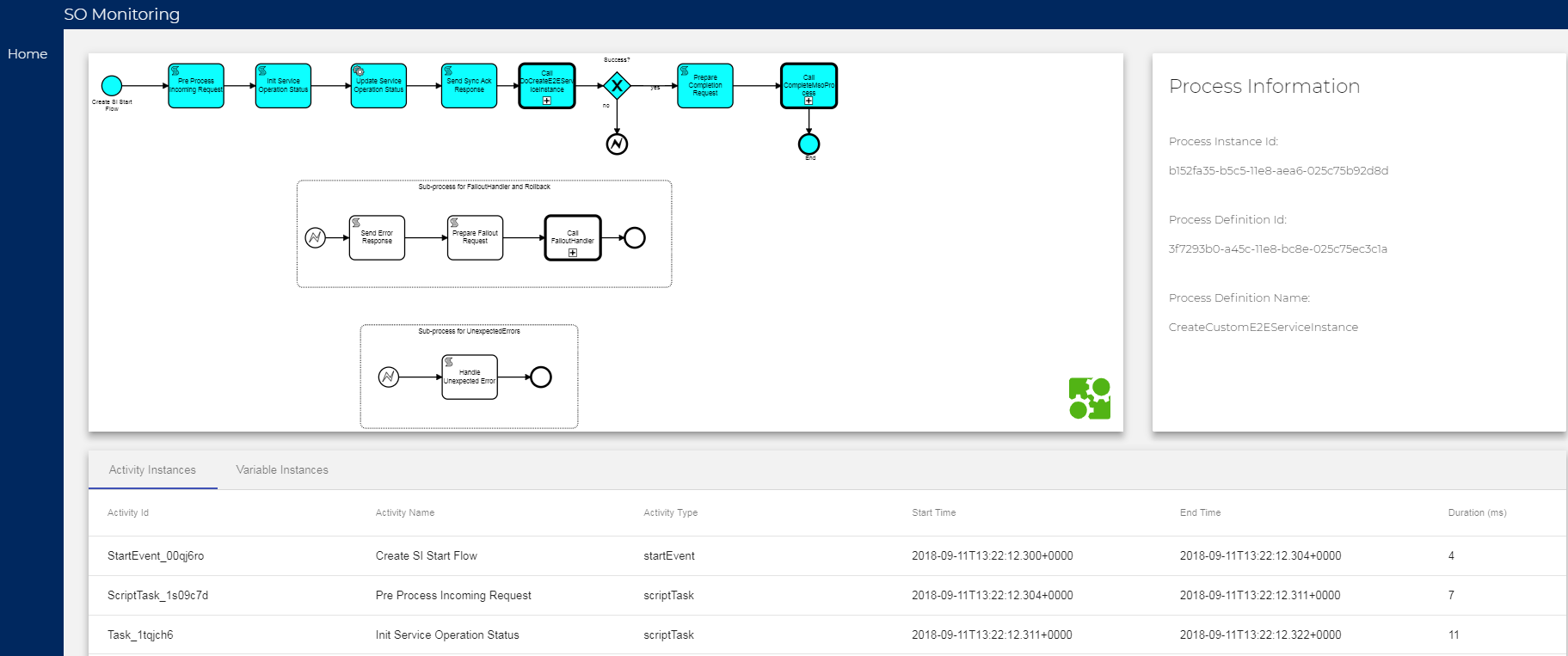...
The SO-Monitoring component allows a user to have a detailed monitoring view of the Camunda BPMN workflows that have run, or are running, in SO. It provides a frontend UI that allows users to easily go through a workflow’s different calls and drill up/down through the call activities within the workflow. It also provides a search page for filtering specific results. It allows you to filter by start/end time/date, instance id, request id, service name or by the status of a workflow. The component is extremely useful for debugging and testing workflows of any kind, as it delivers an understandable and simple UI which is much easier to follow than large, cumbersome debug log files. Additionally the UI provides a statistics page, based on your current search parameters, that provides the percentages of complete, failed, in progress, pending and unlocked workflows.
...
Steps to add SO-Monitoring to the Portal:
** Currently In Pre-Casablanca releases you will need to expose the so-monitoring service using a Loadbalancer in order to access it, this is simple until there is a NodePort assigned to SO-Monitoring**
...
- Click “Application Onboarding”, then “Add App” in the top right.
- Fill out the required Application Details (Name, URL, REST API URL, Username, Password) as shown here:
- Application Name: SO-Monitoring
- URL: http://so-monitoring:909130224
- Rest API URL: http://so-monitoring:909130224
- Username: user
- Password: password
- Namespace: SO-Monitoring
- Please note, the Application Name, Username and Password can be given any values currently.
- Now simply go to the “Application Catalog” tab on the left of the page, then tick your Monitoring app to enable it. (Whatever you set Application Name as should show up here.)
- Click the “Home” tab and you should be able to access the Monitoring app now.
...
In order to find the workflow that you are attempting to monitor you will need at least one of the following values of the service instance: Service Instance ID, Request ID, Service Name or the time/date range in which the workflow started/ended. You can use the filter drop-down boxes to the left of the parameter boxes, i.e. “EQUAL”, “NOT EQUAL” and “LIKE” to search for items equal to, not equal to or similiar to your parameter. Also, you can filter by the status of a workflow, with the status drop-down box, to further filter your results. Simply enter any of these pieces of information into the search page, ensure the start and end date range includes when the workflow would have run and press the search button. Once your results list has been returned you can click on the results to see the workflow in the graphical BPMN viewer.
From here you can inspect the different calls and variables throughout the workflow, by using the "Activity Instances" and "Variable Instances" tabs. Clicking on one of the sub process call, within the diagram, to open them in the graphical BPMN viewer (The boxes with a + at the bottom of them are call activities to sub processes. This is how you drill down through a workflow, you can also safely traverse back “up” through the flows with your browser’s back button. The cyan highlighting shows the flow of the path taken by the workflow, and this will go down through each of the sub processes as well.
In the BPMN viewer, manipulation of the returned illustrated flow is possible by using the following methods. On the left side of the viewer window there are three symbols. will zoom in on the flow with each subsequent click. will zoom out on the flow with each subsequent click. will fit the flow to the full window, if it has been zoomed in, zoomed out or moved. Along with these controls, the user can left-click and drag to move the flow within the canvas to the user desired position.
SO-Monitoring Service Statistics
...
Replacing <namespace> with your environments namespace and <soMonitoringPodName> with the full name of your SO-Monitoring pod. This command will give you some detailed information from the execution of the pod.
CORS error
Pre-Dublin SO Monitoring Deployments may experience CORS issues.
To check for this error open up the console of the browser you are using. In Mozilla Firefox do this by pressing CTRL + SHIFT + C and then selecting the console. In Google Chrome this is done by CTRL + SHIFT + I and then selecting the console. If an exception relating to CORS is displayed, then this issue must be addressed.
This can be dealt with in two ways. Either using an extension or by disabling CORS in the browser.
If using Firefox then the CORS Everywhere extension should be used. While if using Chrome the Allow-Control-Allow-Originshould be used.
To disable the CORS in Chrome, follow this thread (https://stackoverflow.com/questions/3102819/disable-same-origin-policy-in-chrome).
Internal Service Error occured for operation : GET please check backend service log. status code: 500
This can be checked by following the below guidelines:-
- Press F12 on the browser to load the developers mode
- Click on Console(clear it if required)
- Observe errors(red text) and if the description is similar to "Error : No serializer found for class org.onap.so.bpmn.core.RollbackData and no properties discovered to create BeanSerializer"
This issue 'could' be associated with any one of the objects being used in the BPMN flows,when it's declared as a java object but attempted to be serialized without marking/declaring it as serializable.
SO Monitoring app creates a blank tab
If when selecting SO Monitoring from the portal a blank tab labeled “SO Monitoring” is returned, then the issue may relate the URL you are using in portal by default.
A fix for this issue is to change “https” to “http” and change the port from “30225” to “30215”, within the browser url.
IE using this url “http://portal.api.simpledemo.onap.org:30215/ONAPPORTAL/applicationsHome” instead of the default “https://portal.api.simpledemo.onap.org:30225/ONAPPORTAL/applicationsHome”.





